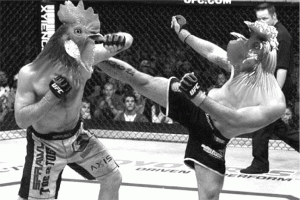The dangers of banning the unifying of MMA
By Steve Marks
“Human cockfighting.” That’s what Senator John McCain called mixed martial arts (MMA) in 1997 when he attempted to have it banned on a national level. The sport McCain was referring to at the time was little more than two brawlers grinding it out until one went limp or quit.
Fast-forward to 2009, and MMA, now most often branded as “Ultimate Fighting,” has become the fastest growing sport in North America. Yet even now, after ten seasons of exposure from reality TV and pay-per-view numbers at over a million viewers per event, a stigma still looms over the sport.
Modern mixed martial arts consists of two opponents competing for a victory via knockout, submission or judges’ decision (wherein a panel determines a winner based on aggressiveness, damage and ring control). Early MMA focused on one type of martial art versus another with a very limited set of rules.
In the last two decades, the sport has evolved in such a way that each fighter must have some knowledge of both striking and submission to effectively compete. The introduction of sanctioning bodies to regulate fights and create a concrete rule-set has created a much stricter set of parameters under which fighters must operate.
The sport has evolved a great deal since McCain’s statement in 1997, but does this evolution mean the sport is any safer? After all, the only thing physically protecting the fighters is a pair of 4 oz gloves serving only to prevent knuckles from breaking.
Those who lament the sport’s existence often tend to cite the near certainty of serious injury or death to the athletes. However, since 1998 only three recorded deaths directly resulting from mixed martial arts have been filed, with only one of them occurring under a sanctioned body in the United States.
To put that number into perspective, one can look at the same statistics provided for boxing in the United States between 1998 and 2006; professional boxing has recorded 70 deaths. The discrepancy is staggering, yet there are still almost a dozen states in which amateur and professional mixed martial arts is banned.
To date, 39 states have legalized professional mixed martial arts bouts, with many falling under the same jurisdiction of that state’s boxing commission. However, a lack of unified acceptance of the sport creates for a situation where rules and medical regulation vary from state to state. Slight changes in rules, such as the prohibition of stomps and/or elbow strikes to a downed opponent, create a dangerous atmosphere for out of state fighters who may find themselves unprepared to defend against an attack they think is illegal.
The most dangerous aspect of no unifying body in MMA comes from the lack of public understanding of the sport leading to uneducated injury. In two of the aforementioned deaths associated with MMA in the last decade (outside of the U.S.), direct blame was placed upon poor organizational practices.
In the first, a man from the Ukraine died from a brain hemorrhage after fighting without medical clearance from a governing body. The other, a Korean fighter, died post-fight because of an ill-equipped medical staff. These kinds of accidents have not yet come to the United States, but with MMA skyrocketing towards mainstream popularity, it seems inevitable that deaths due to negligence are only going to increase.
Most realistic, though possibly most pessimistic, a danger is for a younger generation. Many boxing gyms and karate dojos are starting to adopt mixed martial arts programs into their weekly regimen, but with such a strict opposition to the sport, gyms run the risk of having equipment or trainers that are inadequate or unqualified.
Though we see it covered on ESPN and in gyms all over the country, the stigma surrounding mixed martial arts as brutal only helps to keep the sport more dangerous. The more society sweeps the sport under the rug as barbaric, the more damage is done to legitimizing and stabilizing a sport with a great deal of potential, which has already begun a meteoric rise into the mainstream. The deaths like that of those fighters overseas should not perhaps be a damnable piece of evidence, but rather a cautionary tale of what the sport can become if continued bans and stringent rules prevent regulations from being put into place.
____________________________________
Steve Marks is a senior cinema and photography major. He fights his split personality every Tuesday night when he’s not at the blood parasites support group. E-mail him at smarks1@ithaca.edu.

